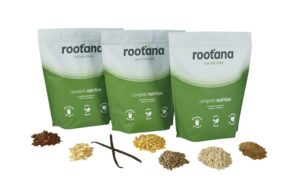There’s a new meal replacement shake in town, generating a lot of excitement. Rootana is a meal replacement shake that avoids the use of artificial sweeteners or preservatives. It also prioritizes high quality ingredients to promote health and weight loss. But does it live up to the hype? This Rootana meal replacement shake review will find out.
Rootana at a glance
- 400 calories per serving
- 13-16 grams of fat (depending on taste)
- 43-47 grams of carbohydrates
- 7.1-9.4 grams of fiber
- 20-21 grams of protein
- 24 vitamins and minerals (20% RDA)
- No artificial sweeteners
- No preservatives
- No artificial colors
- Non-GMO
There are three flavors of Rootana available, and the macros vary slightly depending on your choice. The original flavor has the highest fat and protein, while the vanilla has the highest number of carbs. But the difference is minimal and will not affect your results.

How does Rootana compare to other Meal Replacement Shakes?
What makes Rootana different from all other replacement shakes is its commitment to avoiding artificial sweeteners, preservatives and colorings. No other company does this. Even the most health conscious use stevia for sweetness.
Rootana uses natural coconut sugars, which are very low in calories and won’t make your shake taste too sweet.
In terms of its macronutrient profile, it’s similar to Huel, with decent protein, decent fiber, and plenty of low-GI healthy carbohydrates and healthy fats.
It is not as high in proteins and fibers as Instant Knockout Complete, but Rootana is intended more for a balanced and healthy lifestyle, while Complete is designed mainly for weight loss. Hence the largest amount of protein and fiber per serving.

Rootana ingredients
There are six main ingredients found in Rootana, and we’ll go through each one in this section. There is also a mixture of vitamins and minerals, which is pretty self-explanatory.
Oatmeal powder
Considered the healthiest carbohydrate in the world, oatmeal is very popular in replacement shakes because it offers many benefits. First, the taste and texture of oats is wonderful, helping to create a creamy and delicious batter. Oats are also very sustainable, making them an excellent choice for anyone who cares about the environment.
But it is nutritionally that oats stand out. They are an excellent source of soluble fiber, which is known to reduce the risk of cardiovascular disease [1] and help reduce the risk of certain cancers [2]. Oats can also lower blood pressure, reduce bad cholesterol, and remove triglycerides from the blood.
Oats are also very filling, meaning they can keep you feeling full for a long time after you finish your shake. A 2016 study in the Journal of the American College of Nutrition found that oats increased satiety and reduced total calories consumed throughout the day. [3].
Thanks to the fiber and phytochemicals found in oats, they can help improve your gut health and digestive process. They can also help contribute to a robust immune system.
Pea Protein Isolate
Pea protein is an excellent choice for vegans and allergy sufferers because it is plant-based and hypoallergenic. It is a complete protein that contains all the essential amino acids needed to build muscle. Other than that, it works like any other form of protein. It helps build muscle, prevents muscle loss during dieting, and increases satiety. In addition, Pea protein has a high concentration of BCAAs, making it ideal for preserving muscles during a caloric deficit.
Golden ground flax seeds
Omega 3 fatty acids are a crucial component of health, but most sources come from fish, which is not ideal for vegans or people who do not like the smell or taste of fish. Flaxseed is a vegetable source of alpha-linoleic acid (ALA), the building block of omega 3.
Thanks to its fiber content, flaxseed can help stabilize blood sugar, increase satiety and help weight management. In addition, flax seeds are particularly effective in lowering cholesterol levels that allow good HDL cholesterol to thrive. [4].
Sunflower oil
Rich in oleic acid, sunflower oil has been shown to lower cholesterol levels and reduce the risk of heart disease. [5]. The oil is also a good source of vitamin E and is high in antioxidants.
Coconut sugar
Instead of artificial sweeteners, Rootana uses natural coconut sugars that provide fiber and nutrients like calcium, potassium and zinc.
Sunflower lecithin
The primary function of sunflower lecithin is as an emulsifier. It helps provide stability and mixability. But sunflower lecithin has also been shown to improve mood and cognition by helping to support healthy brain function.
How to use Rootana
Rootana is designed to be taken as a substitute for breakfast or lunch. However, it can be used for both. Make a shaker with 500 ml of cold water, and add five spoons of Rootana (100 grams). Stretch the shaker’s cover, and then shake as hard as possible for 10-20 seconds.
You can also choose to blend your Rootana if you have a good blender. Finally, add in crushed ice for a smooth and cold drink. Perfect in hot weather.
Rootana Side Effects
Since Rootana uses hypoallergenic ingredients, the risk of side effects is very low. Some bloating may occur if you are not used to a high fiber diet, but other than that, Rootana is perfect for new users.

Rootana Meal Replacement Shake Review
Rootana is an excellent replacement shake, perfect for anyone who wants to avoid the use of artificial sweeteners, preservatives or colorings. It is high in protein, high in fiber and rich in vitamins and minerals. Rootana’s commitment to using natural food ingredients is second to none, and we are excited to see what the future holds.
If you want to lose weight, maintain a healthy weight, or even increase your weight and build some muscle, Rootana is an excellent choice. Combining it with exercise, a nutritious diet, good sleep and stress management will give the best results.
Rootana is a cleaner and healthier alternative to other meal replacement shakes. Perfect for health conscious people who want to improve their lifestyle. Check out Rootana’s website here.
References
[1] https://www.ncbi.nlm.nih.gov/pmc/articles/PMC5731843/
[2] https://www.ncbi.nlm.nih.gov/pmc/articles/PMC6770293/
[3] https://www.tandfonline.com/doi/full/10.1080/07315724.2015.1032442
[4] https://pubmed.ncbi.nlm.nih.gov/27807734/
[5] https://pubmed.ncbi.nlm.nih.gov/15983523/
